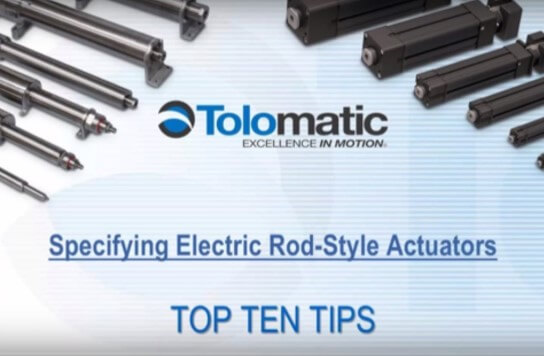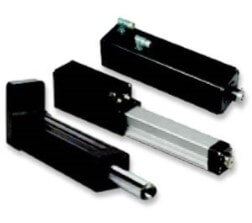Webinar: tips on electric rod actuator selection
By Tolomatic on May 3, 2016
 When you’re called on to specify electric linear actuators, one of the critical decisions you’ll face is whether to use a rodless or rod-style model. Either actuator type has advantages and disadvantages.
When you’re called on to specify electric linear actuators, one of the critical decisions you’ll face is whether to use a rodless or rod-style model. Either actuator type has advantages and disadvantages.
In general, if the actuator has to carry a load, a rodless product is what you need. However, if a load needs to be pushed or pulled, select a rod-style actuator.
Once you’ve decided on an electric rod actuator, you’ll need to consider several factors to ensure you select the best model for your application. A webinar by Tolomatic offers an excellent review of these factors.
You also can download our white paper: How to specify electric rod-style actuators for optimal performance, reliability and efficiency.
Consider this
It takes careful thought and calculation to select the best electric rod actuator for an application. That upfront thinking will ensure maximum reliability and efficiency from the device. Here are our ten tips to help you through this analysis when you’re specifying electric rod actuators:
- Calculate the loads precisely.
You’ll need to know the static and dynamic loads to accurately specify the motor, screw or bearing. The system may fail if its components can’t handle the loads.
- Calculate for electric, not fluid power.
It’s common to over-size the actuator when specifying pneumatic and hydraulic models. The purchase price of a fluid power cylinder often is not a huge factor so over-sizing can seem like inexpensive insurance. However, the cost impact of over-sizing electric rod actuators is significant. The cost of the actuator will be higher, and you’ll need to purchase a larger motor and more. (Electric actuator sizing software can help you get around this problem.)
- Know the duty cycle.
Duty cycle is defined as a ratio of operating time to resting time of an electric actuator expressed as a percentage. An actuator that is moving for two seconds and stopped for two seconds has a duty cycle of 50 percent. Underestimating the duty cycle can lead to premature failure while overestimating may lead to over-sizing and higher costs. Also, duty cycle is used to calculate the L10 life of a ball or roller screw actuator. (Download our new Guide to calculating actuator life here.)
- Understand force and velocity requirements.
These factors combine to affect motors, screws, and nuts in electric rod actuators. An incorrect or incomplete understanding of these variables could lead you to specify the wrong components. If components can’t handle the application’s force and velocity, the motion control system may under-perform.
- Avoid side loading or add proper guides.
Electric rod actuators are prone to damage and wear when they have to deal with even moderate side loads. Side loading can deflect the rod and make the actuator less accurate. Guides and appropriate mounting ensure that the rod and load are accurately aligned.
- Set speed limits.
In manufacturing going faster often means that more can be produced in less time. But operating at a speed that's too fast can cause trouble. For example, if the stroke speed of the electric linear actuator goes over the critical speed of the lead screw, the resulting oscillation of the screw puts stress on the support bearings and can even cause system-wide failure.
- Match the actuator’s peak thrust to the application.
If an application calls for a given peak thrust and the actuator manufacturer’s thrust curve says the model cannot achieve it, believe the thrust curve and find a model that matches your requirements.
- Understand the application’s accuracy and repeatability
High accuracy can come with a higher price tag so be sure it’s really what you need before you pay for it. You may be able to save money and build an effective, efficient motion control system by looking for a high degree of repeatability instead. You will avoid excess costs and design a system with the best overall value if you take time to understand the specific needs of your application.
- Factor in the environment.
Heat, cold, vibration, dust, and washdowns all affect a linear actuator’s performance. You may need to  spec the right IP rating if the linear actuator has to deal with dust or moisture.
spec the right IP rating if the linear actuator has to deal with dust or moisture.
- Keep total envelope size in mind.
There’s a difference between the overall length of an electric actuator and its working stroke length. Keep both in mind or your electric actuator system will not fit the space allowed. At the same time, select a drive system that has the power you need. Reverse-parallel motor mounting saves space but can’t match the performance of an inline drive system. If you specify a linear actuator system solely on its footprint, you may wind up with a system that under-performs.
These are the critical factors that go into the design of a motion control system. If you take the time to analyze the variables and component specifications carefully in the early stages of your project, you’ll create a system that’s long-lasting, economical, and effective.
Learn more
Download our white paper: How to specify electric rod-style actuators for optimal performance, reliability and efficiency.

 Ask an Engineer
Ask an Engineer